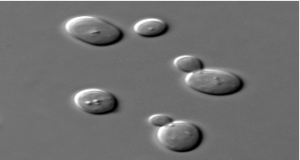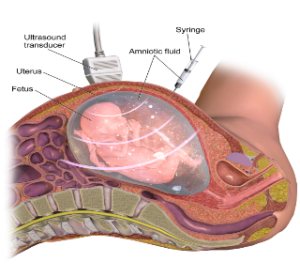This page contains the AQA GCSE Biology B15 Genetics and Evolution Questions and kerboodle answers for revision and understanding . This page also contains the link to the notes and video for the revision of this topic.
Banner 1 B15.1 The History of Genetics AQA GCSE BIOLOGY B15 Genetics and Evolution Kerboodle Answers: Page No. 235
1 Mendel’s experiments with peas convinced him that there were distinct’ units of inheritance’ that were not blended together in offspring. Gregor Mendel, through his work on pea plants, discovered the fundamental laws of inheritance. He deduced that genes come in pairs and are inherited as distinct units, one from each parent. Mendel tracked the segregation of parental genes and their appearance in the offspring as dominant or recessive traits. He recognized the mathematical patterns of inheritance from one generation to the next. Mendel’s Laws of Heredity are usually stated as:
1) The Law of Segregation: Each inherited trait is defined by a gene pair. Parental genes are randomly separated to the sex cells so that sex cells contain only one gene of the pair. Offspring therefore inherit one genetic allele from each parent when sex cells unite in fertilization.
2) The Law of Independent Assortment: Genes for different traits are sorted separately from one another so that the inheritance of one trait is not dependent on the inheritance of another.
3) The Law of Dominance: An organism with alternate forms of a gene will express the form that is dominant.
2a People did not accept Mendel’s Ideas when they were first published because:
a) His results were published in an obscure journal (The Annual Proceedings of the Natural History Society of Brunn in 1865 in the paper entitled Experiments in plant Hybridization)
b) Scientists failed to notice his work because at that time they were busy with the controversy arisen by Darwin’s Theory on the Origin of Species.
c) Scientists of that period were ignorant about cytological basis of heredity. Mendel’s concept was far ahead of his time.
d) Mendel himself was not very sure of his findings.
e) Mendel lacked an aggressive approach.
Mendel’s findings remained obscure until 1900.
b The development of the microscope played an important part In helping to convince people that Mendel was right. Mendel was headed of his time. As no one knew about genes or chromosomes people simply didn’t understand his theories. Sixteen year after mendal’s death in 1884, his work was finally accepted. By the late 19th centuary, people had seen chromosomes through a microscope. They had observed the dance of the chromosomes during cell division.
3 Throughout the 20th century, many scientists have tried to study deoxyribonucleic acid (DNA). In the early 1950s two scientists, Rosalind Franklin and Maurice Wilkins, studied DNA using x-rays.
Franklin produced an x-ray photograph that allowed two other researchers, James Watson and Francis Crick to work out the 3D structure of DNA. The structure of DNA was found to be a double helix.
In 1962 Crick and Watson, along with Wilkins, received the Nobel Prize in Physiology or Medicine for their discovery. Rosalind Franklin had died four years earlier and her pivotal contribution wasn’t acknowledged until much later.
Banner 2 B15.2 Theories of Evolution AQA GCSE BIOLOGY B15 Genetics and Evolution Kerboodle Answers : Page No. 237
1 a Evolution is the change in the characteristics of a species over several generations and relies on the process of natural selection.
- The theory of evolution is based on the idea that all species are related and gradually change over time.
- Evolution relies on there being genetic variation in a population which affects the physical characteristics (phenotype) of an organism.
- Some of these characteristics may give the individual an advantage over other individuals which they can then pass on to their offspring.
b Natural selection, process that results in the adaptation of an organism to its environment by means of selectively reproducing changes in its genotype, or genetic constitution.
- Charles Darwin’s theory of evolution states that evolution happens by natural selection.
- Individuals in a species show variation in physical characteristics. This variation is because of differences in their genes
- Individuals with characteristics best suited to their environment are more likely to survive, finding food, avoiding predators and resisting disease. These individuals are more likely to reproduce and pass their genes on to their children.
- Individuals that are poorly adapted to their environment are less likely to survive and reproduce. Therefore their genes are less likely to be passed on to the next generation.
- As a consequence those individuals most suited to their environment survive and, given enough time, the species will gradually evolve.
2 Jean-Bsptiste Lamarck’s theory affect the development of ideas about evolution as follows;
Use and Disuse
The classic example used to explain the concept of use and disuse is the elongated neck of the giraffe. According to Lamarck’s theory, a given giraffe could, over a lifetime of straining to reach high branches, develop an elongated neck. A major downfall of his theory was that he could not explain how this might happen, though he discussed a “natural tendency toward perfection.” Another example Lamarck used was the toes of water birds. He proposed that from years of straining their toes to swim through water, these birds gained elongated, webbed toes to better their swimming.
These two examples demonstrate how use could change a trait. By the same token, Lamarck believed that disuse would cause a trait to become reduced. The wings of penguins, for example, would be smaller than those of other birds because penguins do not use them to fly.
Lamarckian Inheritance
The second part of Lamarck’s mechanism for evolution involved the inheritance of acquired traits. He believed that traits changed or acquired over an individual’s lifetime could be passed down to its offspring. Giraffes that had acquired long necks would have offspring with long necks rather than the short necks their parents were born with. This type of inheritance, sometimes called Lamarckian inheritance, has since been disproved by the discovery of hereditary genetics.
An extension of Lamarck’s ideas of inheritance that has stood the test of time, however, is the idea that evolutionary change takes place gradually and constantly. He studied ancient seashells and noticed that the older they were, the simpler they appeared. From this, he concluded that species started out simple and consistently moved toward complexity, or, as he termed it, closer to perfection.
3 a Darwin’s Rhea, Rhea pennata, also known as the Lesser Rhea, is a large flightless bird, but the smaller of the two extant species of rheas. It is found in the Altiplano and Patagonia in South America.a new form of the common rhea, an ostrich – like bird- although he had finished eating it before he noticed the differences. Finding two different type of the same bird living in slightly different area set Darwin thinking.
b When Charles Darwin visited the Galapagos, he was repulsed by the marine iguanas, famously referring to them in his journal as “imps of darkness.” But these “disgusting, clumsy lizards” were one of the keys that helped Darwin unlock the secrets of his theory of evolution.
On his visit to the Galapagos Islands, Charles Darwindiscovered several species of finches that varied from island to island, which helped him to develop his theory of natural selection.They also helped investigate evolutionary changes in Darwin’s finches.
c The Voyage of the Beagle is the title most commonly given to the book written by Charles Darwin and published in 1839 as his Journal and Remarks, bringing him considerable fame and respect. This was the third volume of The Narrative of the Voyages of H.M. Ships Adventure and Beagle, the other volumes of which were written or edited by the commanders of the ships. Journal and Remarks covers Darwin’s part in the second survey expedition of the ship HMS Beagle. Due to the popularity of Darwin’s account, the publisher reissued it later in 1839 as Darwin’s Journal of Researches, and the revised second edition published in 1845 used this title. A republication of the book in 1905 introduced the title The Voyage of the “Beagle”, by which it is now best known.
d In 1856, 20 years after his return from the voyage on the Beogle, Charles Darwin finally began writing a book about his discoveries. Imagine the effect on him when in 1858 he realised someone else might publish first! Wallace’s ideas were not as carefully crafted as Darwin’s, and they were not backed up by years of research. Astonishingly the two papers, published by the Linneaen Society in 1358, went almost unnoticed, with the Society President complaining that there had been no striking discoveries during theyear. the very next year, The Origin of Species was published and Darwin became forever associated with the theory of evolution by natural selection.
Banner 3 B 15.3 Accepting Darwin’s Ideas AQA GCSE BIOLOGY B15 Genetics and Evolution Kerboodle Answers : Page No. 239
1 Different finch species Darwin found on the Galapagos Islands looked different because the finches and other birds had adapted to the islands and specific environments where they live, leading to the theory that species are not fixed and unchanging; instead, they evolve over time from common ancestors. Due to the absence of other species of birds, the finches adapted to new niches. The finches beaks and bodies changed allowing them to eat certain types of foods such as nuts, fruits, and insects.
2 Experiments of Darwin done at home to gain further evidence are;
Charles Darwin bred pigeons in his garden. They were not a hobby, but an experiment. By crossing birds with different characteristics, he could generate different offspring. Some had brown feathers, others white. Some had long legs, others very short beaks.By artificially selecting in this way, he gathered valuable evidence for his theory of evolution by natural selection. Fancy pigeon breeders have created hundreds of varieties that look dramatically different to wild pigeons. But they all come from one species, Columba livia. Darwin was fascinated by how one species could be manipulated to such extremes. He used this as an analogy.
If breeders can artificially manipulate the way a single species looks in captivity, perhaps the environment can manipulate all species naturally in the wild. The similarity between artificial selection and natural selection is at the heart of Darwin’s revolutionary book On the Origin of Species.When he had completed his experiments, he gave all 120 of his pigeon specimens to the Museum, some bred by him, others sent to him by a global network of fellow naturalists.
3 There were many different reasons Darwin’s theory of natural selection was only gradually accepted in some places. They include: • The theory of evolution by natural selection challenged the belief that God made all of the animals and plants that live on Earth. This religious view was the generally accepted belief among most people in early Victorian England, • In spite of all Darwin’s efforts and experiments, many scientists felt there was not enough evidence to convince them of his theory. • There was no way to explain how variety and inheritance happened. The mechanism of how inheritance happens-by genes and genetics – was not known until 50 years after Darwin published his ideas. Because there was no mechanism to explain how characteristics could be inherited, Darwin’s theory was much harder for people to accept and understand.
Banner 4 B 15.4 Evolution and Speciation AQA GCSE BIOLOGY B15 Genetics and Evolution Kerboodle Answers : Page No. 241
1 a Populations can become isolated by geographical isolation. This is when two populations become physically isolated by a geographical feature, for example, a new mountain range, a new river, or an area of land becoming an island. Earthquakes can separate areas of land, and volcanoes can produce completely new islands. The formation of islands often leads to speciation.
b A population becomes isolated because of new environmental conditions. Alleles for characteristics that enable organisms to survive and breed successfully in the new conditions will be selected. These are likely to be different from the alleles that gave success in the original environment. As a result of the selection of these different alleles, the genetic variation between the populations will increase. Eventually, the characteristics change so much that they can no longer interbreed to produce fertile offspring with the original organisms- a new species has formed.
2 Speciation occurs when two or more populations become so genetically distinct that they no longer interbreed with one another.
Explanation:
Speciation occurs when two or more populations become so genetically distinct that they no longer interbreed with one another.
There are multiple ways this can occur. The natural ways speciation can occur are allopatric, parapatric, and sympatric speciation. (Note: speciation can also occur unnaturally in the laboratory or due to selective breeding and so forth)
Allopatric speciation is when populations become separated geographically and diverge over time due to natural selection, mutations, and genetic drift within each population.
For example, if a river changes its course over time and two populations of a species that used to interbreed and exchange genes no loner exchange genes (because they can’t or don’t want to cross the river), those two populations will evolve separately and become distinct species.
Parapatric speciation occurs when two populations are not completely separated. Two populations are largely separated from one another but occasional contact still occurs. However, interbreeding between the two populations is disadvantageous and results in offspring with lower fitness.
Sympatric speciation occurs when there is no geographical barrier but populations diverge regardless. If certain individuals decide to exploit a new niche, over time, they may differ substantially from their main population that they no longer interbreed. There is debate surrounding on often true sympatric speciation occurs. Read more about sympatric speciation here.
Banner 5 B 15.5 Evidence for Evolution AQA GCSE BIOLOGY B15 Genetics and Evolution Kerboodle Answers : Page No. 243
1 a It is impossible to know for sure how life on Earth began because there is little valid evidence. Early forms of life were soft bodied so left few traces behind and many traces of early life have been destroyed by geological activity.
b Fossils are such important evidence for the way life has developed because these are the remains of organisms from millions of years ago that are found preserved in rocks, ice, and other places. For example, fossils have revealed the world of dinosaurs. These giant reptiles dominated the Earth at one stage and died out many millions of years before the evolution of the first human beings.
2 a Rock fossils are the most common form of fossils
b fossils are formed million years ago
c A fossil is the preserved remains or trace of a dead organism.
- Fossils can be formed in several ways:
- Dead animals and plants can be preserved in amber – hardened tree resin – peat bogs, tar pits, or in ice.
- Casts or impressions, such as foot prints, can be covered by layers of sediments. These eventually become rock, so preserving the casts.
- Hard body parts, such as bones, shells and leaves, can be covered by layers of sediments. Over time the parts are gradually replaced by minerals.
3 a Frozen fossils are only formed in special circumstances, so they are rare and usually date back to the Ice Age, but no further. Frozen fossils usually occur when an animal becomes trapped in some way–in mud, tar, a crevasse or a pit–and the temperature drops rapidly, effectively “flash freezing” the animal.
Freezing (refrigeration)-This is the best means of preservation of ancient materials. It happens only rarely. The animal must be continually frozen from the time of death until discovery. That limits the possibilities to cold hardy animals from the last ice age. There have been remarkable discoveries of mammoth and wooly rhinoceros found in ice from Alaska and Siberia. Specimens with flesh, skin, and hair intact have been found. Some of these finds suggest that they were flash frozen, with food still in the mouth and stomach.
b Ice fossils are so valuable to scientists because this kind of evidence helps scientists to check the accuracy of ideas, based on fossil skeletons alone. Frozen fossils can provide scientists with detailed information about the plants and animals that once inhabited the earth. They can also give clues to how the continents of the earth have moved, or “drifted”, over millions of years. In Antarctica, where there are now no trees, frozen fossils of tree trunks 3 feet across have been discovered.
Baneer 6 B 15.6 Fossils and Extinction AQA GCSE BIOLOGY B15 Genetics and Evolution Kerboodle Answers : Page No. 245
1 Hyracotherium is seen as a primitive horse, it actually still had toes rather than hooves, with four on the front feet and three on the rear feet. Hyracotherium was probably not on open plains runner though, and would have been better off roaming the undergrowth around forested areas where it could easily hide its small body from the eyes of the predators of the day. The teeth of Hyracotherium are low crowned, There are forty-four teeth in total with a small gap called a diastema near the front of the mouth similar to many mammals. Hyracotherium is considered to have been quite an intelligent animal for its time with a brain that was proportionately larger in terms of comparison to its body size. It’s thought that this extra brain size was an advancement towards its senses such as sight, smell and hearing so that it could detect the presence of other animals, particularly potential predators.
The middle horse name is actually a reference to the position of Mesohippus in relation to earlier forms like Hyracotherium and larger and later forms. Mesohippus only had three toes in contact with the ground rather than the four seen in Hyracotherium. The centre toe was the main weight bearing appendage and overall the construction of the foot and larger size reveals that Mesohippus would be the faster horse. By having longer legs, Mesohippus could cover a greater amount of ground during foraging while expending a reduced amount of energy in doing so. However this adaptation may have also been pushed by the emergence of predators such as Hyaenodon and nimravids (false sabre-toothed cats) that would have been too powerful for Mesohippus to fight.
2 fossil evidence help us to understand just how much organisms have changed – or not changed – over time as the fossil record can be used to show that organisms changed to meet new conditions. Although most species have become extinct, we see a remarkable diversity of species today. That is because plants and animals adapted to new conditions. This is the result of evolution of species over time.
3 a New predators can wipe out unsuspecting prey animals very quickly if the prey animals do not have adaptations to avoid them. New predators may evolve, or an existing species might simply move into new territory. Sometimes this can be due to human intervention, Hedgehogs were introduced to the Scottish island of North Uist in 1974 to combat the problem of garden slugs. Unfortunately, the hedgehogs bred rapidly and now eat the eggs and chicks of the many rare sea birds that breed on the island
b species that have gone extinct from disease . the rat species Rattus nativitatis inhabited Australia but went extinct in 1908. Scientists believe the black rat, which was an invasive species, or a species that is nonnative to a region, was to blame. The black rat reached Australia via a ship and transmitted disease through fleas to Rattus nativitatis, which may have caused them to go extinct, island populations, like Rattus nativitatis are especially susceptible because they are not exposed to the same diseases as mainland critters.
C one species can cause another to become extinct by successful competition. New mutations can give one type of organism a real advantage over another. Sometimes new species are introduced into an environment by mistake. This means that a new, more successful competitor can take over from the original animal or plant and cause it to become extinct. For example, in Australia, the introduction of rabbits has caused severe problems. They eat so much and breed so fast that the other native Australian animals are dying out because they cannot compete with the rabbits for food.
Banner 7 B 15.7 More about Extinction AQA GCSE BIOLOGY B15 Genetics and Evolution Kerboodle Answers : Page No. 247
1 a four causes of extinction in species of living organisms.
- Overharvesting and overhunting. Overharvesting is when humans make use of a species at a rate greater than the species can reproduce itself.
- Pollution in the form of chemicals and energy is another man-made cause of extinction.
- Habitat destruction involves demolishing a natural environment, thereby displacing or wiping out the organisms that lived there. Destruction occurs through clearing habitats for agricultural purposes and through activities like mining and logging.
- Introducing new predators and food competitors. Humans have the ability, whether intentionally or unintentionally, to introduce exotic species into new environments where they are able to prey on native species or compete with them for food.
b. two possible causes of mass extinction events Are: powerful volcanic eruptions and massive asteroid impacts can trigger mass extinctions.
2 Extinction probably contains three important elements.
(i) For geographically widespredd species, extinction is likely only if the killing stress is one so rare as to be beyond the experience of the species, and thus outside the reach of natural selection.
(ii) The largest mass extinctions produce major restructuring of the biosphere wherein some successful groups are eliminated, allowing previously minor groups to expand and diversify.
(iii) Except for a few cases, there is little evidence that extinction is selective in the positive sense argued by Darwin. It has generally been possible to predict, before the fact, which species will be victims of an extinction event.
3 a The cause of the mass extinction that marks the end of the Cretaceous and the beginning of the Paleogene is a scientific mystery. The extinction wiped out the dinosaurs while most mammals, turtles, crocodiles, salamanders, and frogs survived. Birds escaped. two hypotheses that may explain the Cretaceous extinction: an extraterrestrial impact, such as an asteroid or comet, or a massive bout of volcanism.
The extraterrestrial impact theory stems from the discovery that a layer of rock dated precisely to the extinction event is rich in the metal iridium. This layer is found all over the world, on land and in the oceans. Iridium is rare on Earth but it’s found in meteorites at the same concentration as in this layer. This led scientists to postulate that the iridium was scattered worldwide when a comet or asteroid struck somewhere on Earth and then vaporized. A 110-mile-wide (180-kilometer-wide) crater carved out of Mexico’s Yucatán Peninsula, called Chicxulub, has since been found and dated to 65 million years ago. Many scientists believe the fallout from the impact killed the dinosaurs.
ii the melting of the sea ice (caused by global warming) flooded the seas and oceans with very cold water. A drop in the sea temperature of about 9°C triggered the mass extinction. Their evidence is based on an unexpected change in fossils and minerals that they found in areas of Norway
Banner 8 B 15.8 Antibiotic Resistant Bacteria AQA GCSE BIOLOGY B15 Genetics and Evolution Kerboodle Answers : Page No. 249
1 a MRSA is a bacterium
b not using antibiotics too frequently or when they are not really necessary because Overuse and misuse of antibiotics can promote the development of antibiotic-resistant bacteria. Every time a person takes antibiotics, sensitive bacteria (bacteria that antibiotics can still attack) are killed, but resistant bacteria are left to grow and multiply. This is how repeated use of antibiotics can increase the number of drug-resistant bacteria.
Antibiotics are not effective against viral infections like the common cold, flu, most sore throats, bronchitis, and many sinus and ear infections. Widespread use of antibiotics for these illnesses is an example of how overuse of antibiotics can promote the spread of antibiotic resistance. Smart use of antibiotics is key to controlling the spread of resistance.
B 15.9 Classification: AQA GCSE Biology B15 Genetics and Evolution : Kerboodle Answer Page No. 251
1 Classification is the organisation of living things into groups according to their similarities
2 a i Linnaeus classified nature into a hierarchy. He proposed that there were three broad groups, called kingdoms, into which the whole of nature could fit. These kingdoms were animals, plants, and minerals. He divided each of these kingdoms into classes. Classes were divided into orders. These were further divided into genera (genus is singular) and then species. We still use this system today, but we have made some changes.
ii In the 18th century, Carl Linnaeus published a system for classifying living things, which has been developed into the modern classification system.
The modern classification system categorizes organisms in to 6 different kingdoms.
The kingdoms are :
Archaebacteria – which are single celled microorganisms that are prokaryotes so they don’t have nucleus or organelle that are membrane bound. They don’t need oxygen or light.
Eubacteria- are single celled microorganisms that need light, oxygen, and food but are still prokaryotic. There are heterotrophic chemotrophic , and autotrophic bacteria. Eubacteria organisms are known as true bacteria
Protists- are SINGLE CELLED organisms that live in low oxygen leveled environments by the description of scientist.
Fungi- are either unicellular or multicellular eukaryotic organism. They live in marine, terrestrial, or freshwater environments but they can not move
Plants- are multicellular eukaryotic organism that have a cell wall made up of cellulose. They reproduce sexually and asexually. They are autotrophic which means making their own food.
Animals- are multicellular organism that can move and breathe. They don’t make their own food.
3 a Definitiin of a species: a group of living organisms consisting of similar individuals capable of exchanging genes or interbreeding. The species is the principal natural taxonomic unit, ranking below a genus and denoted by a Latin binomial, e.g. Homo sapiens.
4 a Binomial naming system, also called binominal nomenclature or binary nomenclature, is a formal system of naming species of living things by giving each a name composed of two parts, both of which use Latin grammatical forms, although they can be based on words from other languages.
b Each name has two parts, the genus and the species. For example, human beings belong to the genus Homo, and our species is sapiens – so the scientific name is Homo sapiens. The binomial system is important because it allows scientists to accurately identify individual species
Banner 9 B 15.10 New Systems of Classification AQA GCSE BIOLOGY B15 Genetics and Evolution Kerboodle Answers : Page No. 253
1 a three domains are as follows:
Archaea: primitive forms of bacteria that include the extremophiles, organisms that can live in extreme conditions. This domain contains one kingdom, the archaebacteria
Bacteria: these are the true bacteria and the cyanobacteria, bacteria- like organisms that can photosynthesise.Th is domain contains one kingdom, the eubacteria
Eukaryota: these organisms all have cells that contain a nucleus enclosing the genetic material. There are four eukaryotic kingdoms – the protista, the fungi, the plants, and the animals.
b Here are three distinct domains of organisms in nature: Bacteria, Archaea, and Eukarya. A description of the three domains follows:
1. The Archaea (archaebacteria)
The Archaea possess the following characteristics:
a. Archaea are prokaryotic cells.
b. Unlike the Bacteria and the Eukarya, the Archaea have membranes composed of branched hydrocarbon chains (many also containing rings within the hydrocarbon chains) attached to glycerol by ether linkages
c. The cell walls of Archaea contain no peptidoglycan.
d. Archaea are not sensitive to some antibiotics that affect the Bacteria, but are sensitive to some antibiotics that affect the Eukarya.
e. Archaea contain rRNA that is unique to the Archaea as indicated by the presence molecular regions distinctly different from the rRNA of Bacteria and Eukarya.
Archaea often live in extreme environments and include methanogens, extreme halophiles, and hyperthermophiles. One reason for this is that the ether-containing linkages in the Archaea membranes is more stabile than the ester-containing linkages in the Bacteria and Eukarya and are better able to withstand higher temperatures and stronger acid concentrations.
2 a observations can be made to compare living organisms, modem technology has affected the way organisms are classified. The Bacteria (eubacteria)
The Bacteria possess the following characteristics:
a. Bacteria are prokaryotic cells.
b. Like the Eukarya, they have membranes composed of unbranched fatty acid chains attached to glycerol by ester linkages
c. The cell walls of Bacteria, unlike the Archaea and the Eukarya, contain peptidoglycan.
d. Bacteria are sensitive to traditional antibacterial antibiotics but are resistant to most antibiotics that affect Eukarya.
e. Bacteria contain rRNA that is unique to the Bacteria as indicated by the presence molecular regions distinctly different from the rRNA of Archaea and Eukarya.
Bacteria include mycoplasmas, cyanobacteria, Gram-positive bacteria, and Gram-negative bacteria.
b Classification helps us to build up models of evolutionary relationships as :
The Eukarya (eukaryotes)
The Eukarya (also spelled Eucarya) possess the following characteristics:
a. Eukarya have eukaryotic cells.
b. Like the Bacteria, they have membranes composed of unbranched fatty acid chains attached to glycerol by ester linkage
c. Not all Eukarya possess cells with a cell wall, but for those Eukarya having a cell wall, that wall contains no peptidoglycan.
d. Eukarya are resistant to traditional antibacterial antibiotics but are sensitive to most antibiotics that affect eukaryotic cells.
e. Eukarya contain rRNA that is unique to the Eukarya as indicated by the presence molecular regions distinctly different from the rRNA of Archaea and Bacteria.
The Eukarya are subdivided into the following kingdoms:
a. Protista Kingdom
Protista are simple, predominately unicellular eukaryotic organisms. Examples includes slime molds, euglenoids, algae, and protozoans.
b. Fungi Kingdom
Fungi are unicellular or multicellular organisms with eukaryotic cell types. The cells have cell walls but are not organized into tissues. They do not carry out photosynthesis and obtain nutrients through absorption. Examples include sac fungi, club fungi, yeasts, and molds.
c. Plantae Kingdom
Plants are multicellular organisms composed of eukaryotic cells. The cells are organized into tissues and have cell walls. They obtain nutrients by photosynthesis and absorption. Examples include mosses, ferns, conifers, and flowering plants.
d. Animalia Kingdom
Animals are multicellular organisms composed of eukaryotic cells. The cells are organized into tissues and lack cell walls. They do not carry out photosynthesis and obtain nutrients primarily by ingestion. Examples include sponges, worms, insects, and vertebrates.
3 A domain is a taxonomic category above the kingdom level. The three domains are: Bacteria, Archaea, and Eukarya, which are the major categories of life. Essentially, domains are superkingdoms. A kingdom is a taxonomic group that contains one or more phyla. The four traditional kingdoms of Eukarya include: Protista, Fungi, Plantae, and Animalia.
Banner 10 AQA GCSE Biology B15 Genetics and Evolution Summary questions: Kerboodle Answer Page No. 254
1 a Jesn-Baptiste Lamarck’s theory of evolution:
- Lamarck thought animals adapted and evolved to suit their environment
- All evolved from primitive worms by inheritance of acquired characteristics.
- He believed an organism’s behaviour affected its structures,
- so if an animal used a structure a lot over several generations it would grow and develop
- This improved feature would be passed from parents to offspring. Lamarck thought if a structure wasn’t used, it would shrink and be lost.
b Began with interest in geology, but later observations made on voyage of HMS Beagle sparked his interest in biology and the variety of life.
c Darwin’s Theory of evolution:
All organisms produce more offspring than can survive.
Some offspring are better fitted to the environment than others,
and these are most likely to survive, breed and pass on their beneficial characteristics.
This process of natural selection is most noticeable if there is a change in the environment
d Similarities and differences between Darwin’s and Lamarck’s theories of evolution:
Similarities: All living things evolved from simpler organisms, evolution took a long time, changes passed from parents to offspring;
Differences: Lamarck suggests primitive worms as starting point and that acquired characteristics are passed on, Darwin suggests inherited features are passed on and process of natural selection (‘survival of the fittest’) decides which organisms survive and breed.
e Lamarck’s theory was so important to the way Darwin’s theory was subsequently received because it helped to pave the way for Darwin’s ideas, stimulated Darwin’s thinking, first theory to challenge creation of world by God, instigated debate on origins of life, flaws in Lamarck’s theory made Darwin’s theory more plausible, people could see evidence of natural selection in own livestock.
2 By Looking at the birds in Figure 1.They are known as Darwin’s finches. They live on the Galapagos Islands. Each one has a slightly different beak and eats a different type of food. Natural selection can result in so many different beak shapes from one original type of finch. Pair of finches on one island with high insect population has mutation resulting in offspring with slightly different beak shape that makes it easier to access insects to eat. These birds can get food that others can’t reach, giving them an advantage. They get more food and are more likely to survive, breed, and pass on genes for different beak shape. Eventually a whole group of birds evolves with specialised beaks for feeding on insects. As they are separate from other birds, a new species is formed. Similar processes occur on other islands, where different foods are available. Birds evolve to take advantage of the available food on the islands.
3 a Wallace’s theory of Evolution:
-species exist in different forms
-those species not well adapted to conditions are most likely to die out
b Both islands are isolated with a variety of organisms found only there that are well adapted to the conditions. By Studying these organisms and their adaptations would have helped Wallace in Borneo just as observing adaptations in the Galapagos helped Darwin.
c The arrival of Wallace’s letter and paper was such a shock to Darwin because Darwin was still working on his ideas and building up evidence. He had not expected someone else to come up with essentially the same idea after such a short period of work.
d Wallace’s theories were not strongly supported by evidence. Evidences are specimens and observations of many different species in the Galapagos that were closely related but showed adaptations, results of years of breeding experiments with pigeons, study of barnacles with adaptations to different environments
4 a Classification is an organisation of living organisms into groups based on similarities and differences between their structures and characteristics.
b Two alternative ways of deciding how to classify an organism are simple observation of external physical characteristics, habitat, etc.; analysis of DNA
- to identify genetic links between organisms
c Complexity of classification systems has increased over time alongside our understanding of the number of different types of organism, our ability to use microscopes to compare cellular structures, and our ability to use DNA analysis to determine relationships between organisms. Linnaeus’s two-kingdom system succeeded first by five-kingdom system then by current model of three domains and six kingdoms.
5 a A fossil is remains of organism from many years ago, formed in one of a number of different ways and often found in rocks
b Rock fossils are formed when an animal dies, falls to ground and flesh rots away, leaving skeleton protected under layers of soil and rock for millions of years. Skeleton becomes mineralised and turns to rock. Fossilised skeleton eventually comes to surface as result of earth movements and erosion.
c Ice fossils are formed when an animal dies in conditions where decay cannot not take place, is frozen immediately after death and preserved
d provide evidence of species now extinct;
can be used to make links between modern and extinct species;
rock fossils show anatomical structure and size of organisms
while ice fossils show appearance of animals in life
and can provide evidence of diet and supply DNA for comparison with modern specimens;
complete fossil records show how organisms have changed over time
e Fossils are of little use in helping us understand how life on Earth began as early organisms soft-bodied. so few fossils formed, most early fossils destroyed by geological activity
6 a Every population contains great variation. More offspring are produced than can survive. Only animals and plants best adapted to environment (the ‘fittest’) will survive to breed and pass on their characteristics, ultimately leading to speciation.
b Conditions differ in areas isolated geographically or environmentally.
Different characteristics caused by genetic variation
confer advantages in different environments and will be selected for.
Organisms become increasingly specialised for isolated environment until they cannot interbreed and new species evolve (speciation).
Banner 11 AQA GCSE Biology B15 Genetics and Evolution Practice questions: Kerboodle Answer Page No. 255
01 Darwin – Natural selection
Lamarck – Inheritance of characteristics developed during an organism’s lifetime
Wallace – Speciation
02.1 Tt are the alleles.
02.2 A – Heterozygous is the term that best describes the genotype of the offspring you gave
02.3 Mendel grew hundreds of plants from the seeds of the offspring. He crossed these plants with each other and produced 2480 tall plants and 620 short plants. Gametes of each parent are given. Correct cross from their gametes. Phenotypes of all offspring given. Conclusion: 3: 1 tall to short.
02.4 we call these units of inheritance today as Genes
02.5 The importance of Mendel’s discovery was not recognised until after his death because Genes were not discovered and few scientists read his work.
03.1 Fossil is a remains / print of an organism from hundreds of thousands of years ago found in rocks.
03.2 Parts of an organism have not decayed
Because one or more of the conditions for decay were absent
Hard parts of organism replaced by minerals and become part of the rock over very long periods of time
03.3 Development of resistant bacteria
• Similarities between related living organisms
• DNA analysis
Banner 12
DISCLAIMER
Disclaimer: I have tried by level best to provide the answers and video explanations to the best of my knowledge. All the answers and notes are written by me and if there is any similarity in the content then it is purely coincidental. But this is not an alternative to the textbook. You should cover the specification or the textbook thoroughly. This is the quick revision to help you cover the gist of everything. In case you spot any errors then do let us know and we will rectify it. References: BBC Bitesize AQA GCSE Science Kerboodle textbook Wikipedia Wikimedia Commons Join Our Free Facebook Group : Get A* in GCSE and A LEVEL Science and Maths by Mahima Laroyia: https://www.facebook.com/groups/expertguidance.co.uk/ For Free Tips, advice and Maths and Science Help
This page contains the detailed and easy notes for AQA GCSE Biology Ecology for revision and understanding Ecology.
Banner 1
New (9-1) AQA GCSE Biology Paper 2: Complete Revision Summary
INHERITANCE, VARIATION AND EVOLUTION
Banner 2
4.6 Inheritance, Variation and Evolution
- Sexual and Asexual Reproduction
- Meiosis
- DNA
- Mutation
- Inheritance
- Genetic Diseases
- Sex Determination
- Variation
- Evolution
- Selective Breeding
- Genetic Engineering
- Speciation
- Theories of Evolution
- Speciation
REPRODUCTION – Making more offspring’s
Reproduction is a process in which organisms produce young–ones of the same species. It is one of the fundamental characteristics of living organisms.
|
SEXUAL
|
ASEXUAL
|
| Involves meiosis | Involves mitosis |
| Require both parents and involve fusion of gametes | Require single parent and no fusion of gametes |
| The offsprings are not genetically identical. | The offspring are clone and genetically identical. |
| Produce Variation and lead to evolution | No Variation and Evolution |
| eg human reproduction | eq budding in yeast, cutting, runners in plants |
MEIOSIS
Meiosis is the division of a germ cell that involves two fissions of the nucleus and gives rise to four gametes, or sex cells, each with half the number of chromosomes of the original cell.
- a) It takes place in the sex cells
- b) It is involved in the production of gametes
- c) One parent cell divide to form four daughter cells
- d) Daughter cells are not genetically identical to the parent.
- e) Daughter Cells have half the number of chromosome than the parent.
- f) It produces Variation as it results in crossing over and it leads to evolution.
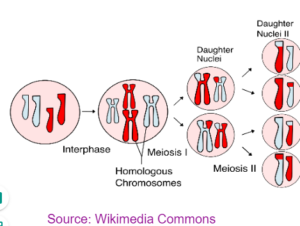
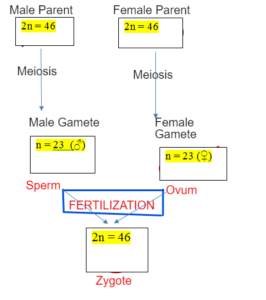
REPRODUCTIVE CYCLE IN FUNGI
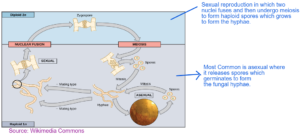
REPRODUCTIVE CYCLE IN PLANTS
Sexual reproduction involves the fusion of pollen grain with the egg nuclei forming zygote which forms the seeds and germinate to form a new plant.
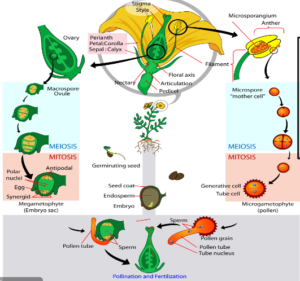
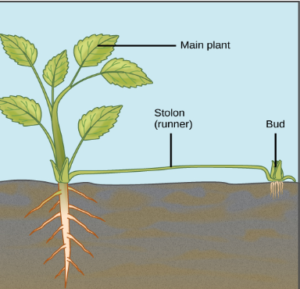
Sexual reproduction in plants in the form of runner, stolon or tuber which produces genetically identical plants.
REPRODUCTIVE CYCLE IN MALARIA
Liver Cell
- Asexual reproduction to form lot of malarial parasite spores
Blood Cells
- Formation of male and the female gamete of the parasite.
Mosquito
- Sexual reproduction in the mosquito forming zygotes and it divides to form spores of pathogens which enters saliva and then is injected into healthy person.
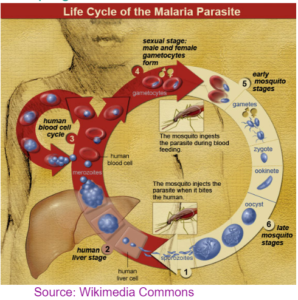
DNA – Deoxyribonucleic acid
Deoxyribonucleic acid (DNA) is a large macromolecule made up of a large number of monomeric units of nucleotides. Each nucleotide is composed of nucleoside and a phosphate group
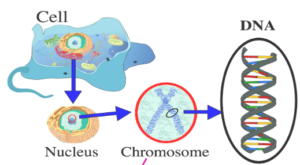
Chromosome – These are the structure that holds our genetic information
DNA – Double Helical Structure which contains genetic information
Gene – It is the segment of DNA that code for protein
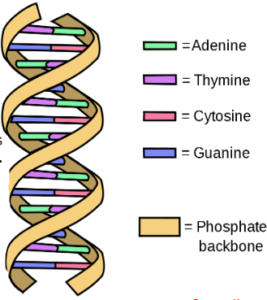
DN
DNA : A POLYNUCLEOTIDE
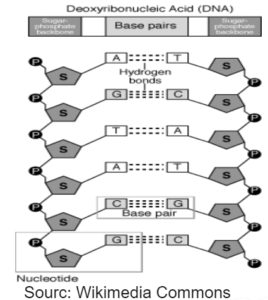
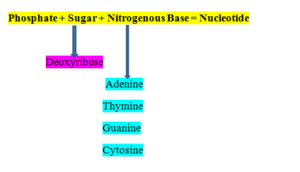
HUMAN GENOME
- Genome is the complete genetic materials of the organism.
- International collaboration to sequence around three billion bases and more than 20,000 genes.
Importance of Human Genome Project
- a) Understanding of genetic Diseases and inherited disorders
- b) Better personalised medicines
- c) Understanding Evolution
- d) Indentifying new drugs target.
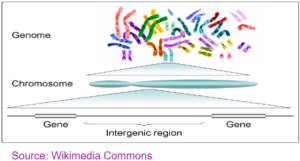
PROTEIN SYNTHESIS
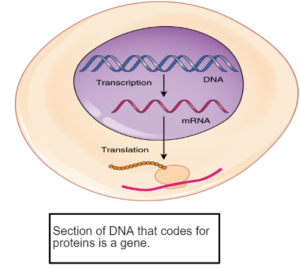
- The DNA copies the code and form mRNA by the process of transcription.
- The mRNA leaves the nucleus and reaches the ribosome.
- The ribosomes reads the bases in the sequence of three bases. The t-RNA brings the corresponding amino acid and forms polypeptide chain .
- The polypeptide chain than forms proteins.
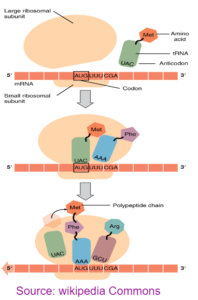
Mutations
- Can be silent, harmful or beneficial
A change in sequence of a gene or DNA
Results in the change in the sequence of the mRNA
Result in the change in amino acid
Result in the formation of non-functional protein or enzyme.
Change the structure of protein, the active site substrate can no longer fit into it
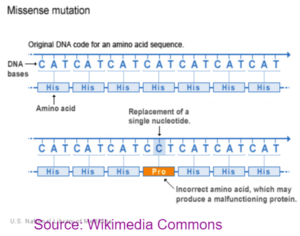
Banner 3
GENETIC TERMS
Chromosome – These are the structure that holds our genetic information
DNA – Double Helical Structure which contains genetic information
Gene – It is the segment of DNA that code for protein
Allele – the alternative factors located at the same locus on homologous chromosomes are called alleles.
Dominant Allele – It is able to express itself even in the presence of its recessive allele.
Recessive Allele – Unable to express its effect in the presence of dominant allele.
Homozygous – individual which contains identical genes or factors of a character on its homozygous chromosomes. E.g TT or tt
Heterozygous – individual which contains the two different or contrasting factors, genes or alleles of a character on its homologous chromosomes. e.g Tt
Genotype – It is the gene complement or genetic constitution of an individual with regard to one or more characters irrespective of whether the genes are expressed or not.
Phenotype – It is the external manifestation of gene products brought to expression
Punnett Square – It is a checker board used to show the result of a cross between two organisms.
Banner 4
Genetic Cross
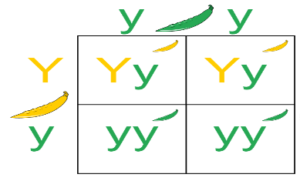
Heterozygous yellow plant with green plant.
Dominant: yellow Y
Recessive –green y
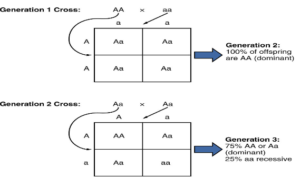
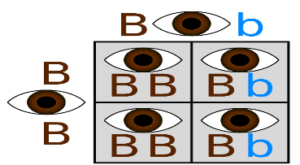
Heterozygous brown eyes with homozygous brown eyes.
B: Brown =Dominant
b: Blue: =Recessive
SEX DETERMINATION
Females XX
Male XY
50% changes of the offspring to be male or female
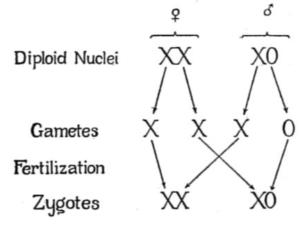
Banner 5
POLYDACTYLY
- Caused by dominant Allele
- If one of the parent has the allele offspring will have a disease.
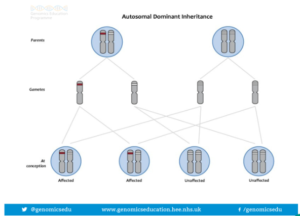
GENETIC DISORDER
- Caused by recessive allele
- Both the parent should have the allele to infect the offspring.
- The mucous becomes sticky and thick.
- It blocks the airways, reproductive tract and digestive tract.
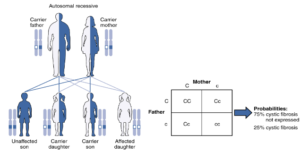
Baneer 6
GENETIC SCREENING
- Provides genetic counselling to the couple and helps to diagnose any problem before birth.
Amniocentesis
- Done at later stages Taking amniotic fluid which has fetal cells .
- The cells are then screened for genetic disorders.
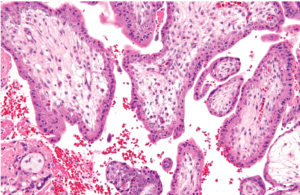
- Chorionic Villi Sampling
- Done at early stage and involve taking fluid from the placenta which contains fetal cells.
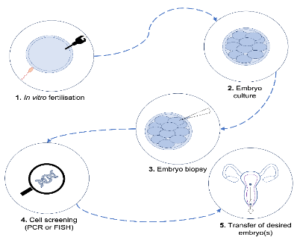
Banner 7
IVF Screening
Involves screening of the embryo after in vitro fertilization.
VARIATION – Differences amongst the individual
| CONTINIOUS VARIATION | DISCONTINOUS VARIATION |
| It is environmental like height, weight. | It is genetic like blood group. |
| Graph is a bell shaped curve | Graph is like column graph having descrete values. |
Natural Selection
“Natural selection is the differential survival and reproduction of individuals due to differences in phenotype. It is a key mechanism of evolution, the change in the heritable traits characteristic of a population over generations.”- Wikipedia
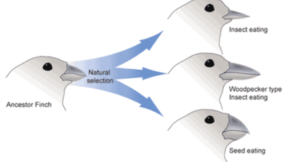
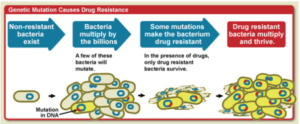
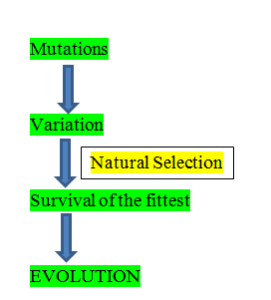
SELECTIVE BREDDING
- Artificially mating the two desirable characters parents to produce required offspring and selecting the ones with the best characteristics.
Applications
- a) Producing high milk yielding cow
- b) Producing diseases resistance and high yield crops.
DISADVANTAGES
- a) Slow process
- b) Time consuming
- c) Causes reduction in gene pool
- d) Undesirable traits can also get selected.
- e) A disease can result in elimination of whole population
Banner 8
GENETIC ENGINEERING
- Altering the gene by inserting the desired gene to produce genetically modified organisms.
- Isolation
- Inserting the gene with the vector (plasmid) to form recombinant DNA
- Introducing the recombinant into bacteria – Transformation
- Selecting transformed bacteria
- Growing transformed bacteria
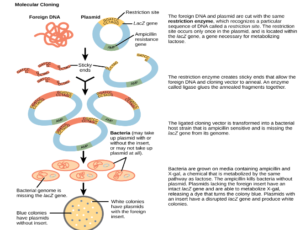
GENETIC ENGINEERING
Examples
- a) Tomato with greater shelf life
- b) Golden Rice which is rich in Vitamin A
- c) Gentically engineered Insulin
- d) Disease resistant crops
- e) Insects resistant crops
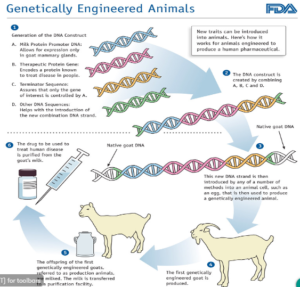
CLONING
- Taking Explant
- Growing and multiplying it in the nutrient medium
- Nutrient medium has all the hormones and minerals
- The new tiny plantelets formed are grown in the field
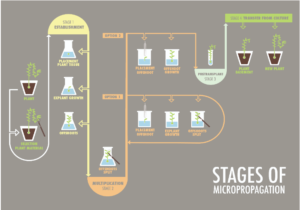
ADULT CELL CLONING
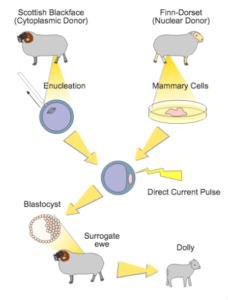
Banner 9
GENETIC ENGINEERING DEBATE
ADVANTAGES
- a) Produce Genetically Engineered crops which are high yielding
- b) Produce nutrient rich crops
- c) Produce high meat and high milk producing cows.
- d) Cure genetic disorders
- e) Can be used to produce medicines
- f) Can be used to produce food through microorganisms.
DISADVATANGES
- a) Reduce genetic diversity and variety
- b) Can result in sterile offspring
- c) Faulty genes or traits can also be transmitted
- d) It is expensive
- e) Ethical and religious concerns of playing with the nature.
- f) It is irreversible
GREGOR MENDEL
Genes Protein Expression
- In the 19th Century
- Father of Genetics
- He studied inheritance pattern in the pea plant
- He said that certain characters are inherited from one generation to another.
- In the 20th Century, the structure of DNA and the genes were discovered to build on Mendel Ideas
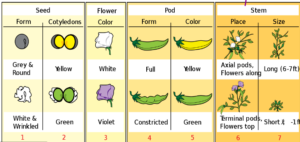
LAMARCK THEORY
Theory of Use and Disuse- If any characters in used it will develop and will be inherited others will be lost.
Example
- a) Giraffe had short necks and use to eat the grass
- b) As all grass were eaten away the giraffe stretched its neck to reach trees.
- c) The necks was used more and developed long necks
- d) The giraffe now acquired long necks.
Not all characters are inherited. Like Einstein did not give birth to an Einstein.
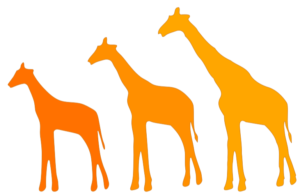
CHARLES DARWIN THEORY OF EVOLUTION
- Each Organism has potential to reproduce more than an environment can sustain
- The population remains constant due to natural selection
- Organisms show variation and nature selects the one which has desired characterstics.
- The one with desired characters survive and reproduce: Survival of the fittest
- The fittest one reproduce and pass the traits to next generation
EVOLUTION
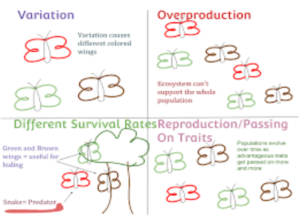
SPECIATION
Formation of new species
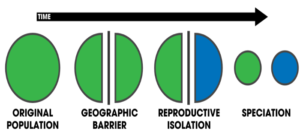
EVIDENCE OF EVOLUTION – FOSSILS
What are Fossils ?
- Fossils are the preserved remains of dead plants and animals that existed millions of years ago.
- Impressions, tracers or foot prints on the rocks are also considered as fossils.
How are Fossils formed ?
- They are formed by incomplete decay of the dead organsims due to hostile conditions for the decomposers.
- The harder part are replaced by minerals and are preserved as rock Impression on mud or rocks
Advantages
- Can give the information about extinct species.
- It can give the information about Evolution.
- Problems with Fossils
- Most of the animals that are soft bodies have no fossils
- Some of the fossils are yet to be discovered.
- No fossil record for some species’
FOSSILS AS EVIDENCE OF EVOLUTION
- Horse fossils record gives us the evidence of evolution
- From five digits it has developed hoofed limb and adapted to run on hard ground
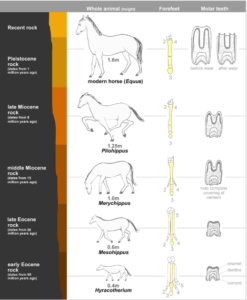
EXTINCTION
It the permanent loss of species
Causes
- a) Environmental Changes
- b) Diseases
- c) Predator
- d) Competition
- e) Catastrophic Event
Banner 10
CLASSIFICATION
Organising the species into groups according to the similar characterstics.
Advantages
- a) Helps to study the organisms easily
- b) Easy to identify unknown species
Basis
- a) Earlier organisms were classified on the basis of obeservable Characteristics
- b) Evolutionary Relationship
- c) DNA or protein sequencing
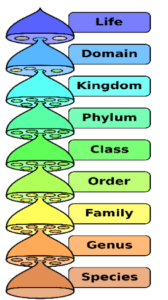
BINOMIAL NOMENCLATURE
- Each species is given two name
- The first name is Genus and is always capital
- The second name is species and it is written in lower case
- The name is italicised and if handwritten is underlined.
Homo sapiens
Genus name species name
- Universally accepted
- Helps the scientists to communicate
THREE DOMAIN CLASSIFICATION
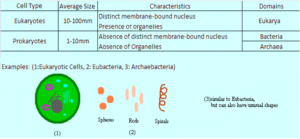
Banner 11
KEY TERMS
Asexual Reproduction – When offspring is produced by a single parent with or without the involvement of gamete formation, the reproduction is called Asexual.
Sexual Reproduction – Development of new individuals through the formation and fusion of male and female gametes.
Mitosis – Mitosis is a process of cell division that results in the development of two genetically identical daughter cells from a single stem cell.
Meiosis – Meiosis is the division of a germ cell that involves two fissions of the nucleus and gives rise to four gametes, or sex cells, each with half the number of chromosomes of the original cell.
Fertilization – Fusion of male and female gamete.
Variation – Variations are the differences found amongst individuals of the same species, race and family.
Natural Selection – Natural selection is the process in which organisms with favorable traits are more likely to reproduce.
Genome – It is a complete set of chromosomes when every gene chromosome is represented singly as in a gamete.
DNA – Double Helical Structure which contains genetic information
Chromosome – These are the structure that holds our genetic information
Allele – the alternative factors located at the same locus on homologous chromosomes are called alleles.
Nucleotide – A nucleotide is an organic molecule that is the constitutive element of DNA and RNA.
Transcription – formation of RNA or ribonucleic acid over DNA template is called transcription.
Translation – It is the process by which linear sequence of nucleotides or codons in a molecule of mRNA directs the specific linear sequence of amino acids in apolypeptide.
Gene Expression – A mechanism by which a gene is able to express itself in the phenotype of an organism.
Mutations – a new sudden inheritable discontinuous variation which is caused by a change in the nucleotide number, type and sequence of a DNA segment representing a gene or cristron.
Homozygous – individual which contains identical genes or factors of a character on its homozygous chromosomes. E.g TT or tt
Heterozygous – individual which contains the two different or contrasting factors, genes or alleles of a character on its homologous chromosomes. e.g Tt
Genotype – It is the gene complement or genetic constitution of an individual with regard to one or more characters irrespective of whether the genes are expressed or not.
Phenotype – It is the external manifestation of gene products brought to expression
Dominant Allele – It is able to express itself even in the presence of its recessive allele.
Recessive Allele – Unable to express its effect in the presence of dominant allele.
Punnett Square – It is a checker board used to show the result of a cross between two organisms.
Sex determination – It is a mechanism which brings about differentiation of sex, i.e, male and female, amongst organisms.
Cystic Fibrosis – Cystic fibrosis is an inherited disorder characterized by the accumulation of thick and sticky mucus that can damage many organs in the body.
Embryo Screening – a single cell is removed from an embryo two or three days after it has been conceived through in vitro fertilization and tested for genetic abnormalities.
Genetic Engineering – Genetic engineering refers to the direct manipulation of DNA to alter the characteristics of an organism (phenotype) in a particular way.
Variation – Variations are the differences found amongst individuals of the same species, race and family.
Evolution – Evolution is the change in the inherited traits of a population from generation to generation.
Natural Selection – Natural selection is the process in which organisms with favorable traits are more likely to reproduce.
Cloning – The term cloning describes several processes that can be used to produce genetically identical copies of a biological entity.
Tissue Culture – the process or technique for growing body tissue in a culture medium outside the body
Genetics – Study of heredity and variation in biological systems is called genetics.
Speciation – formation of new species.
Fossils – A fossil is the hard residue of a plant or a prehistoric animal that is found inside a rock.
Classification – classification is a mode of arranging organisms into categories according to a systematic plan as per nomenclature system.
Domain – Highest taxonomic rank of organisms in the three-domain system of taxonomy
Kingdom – It is the highest category of taxonomic studies.
Banner 12
Disclaimer:
I have tried my level best to cover the maximum of your specification. But this is not the alternative to the textbook. You should cover the specification or the textbook thoroughly. This is the quick revision to help you cover the gist of everything. In case you spot any errors then do let us know and we will rectify it.
References:
BBC Bitesize
Wikipedia
Wikimedia Commons
Image Source:
Wikipedia
Wikimedia
Commons
Flickr
Pixabay.
Make sure you have watched the above videos and are familiar with the key definations before trying these questions. It is also good to time yourself while doing these questions so that you can work on the speed as well.
B15-Genetics And Evolution


